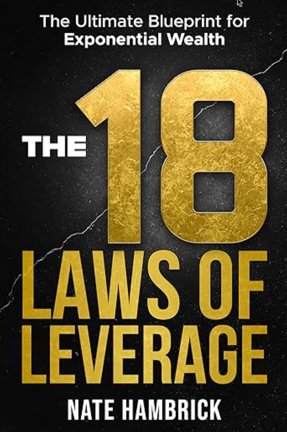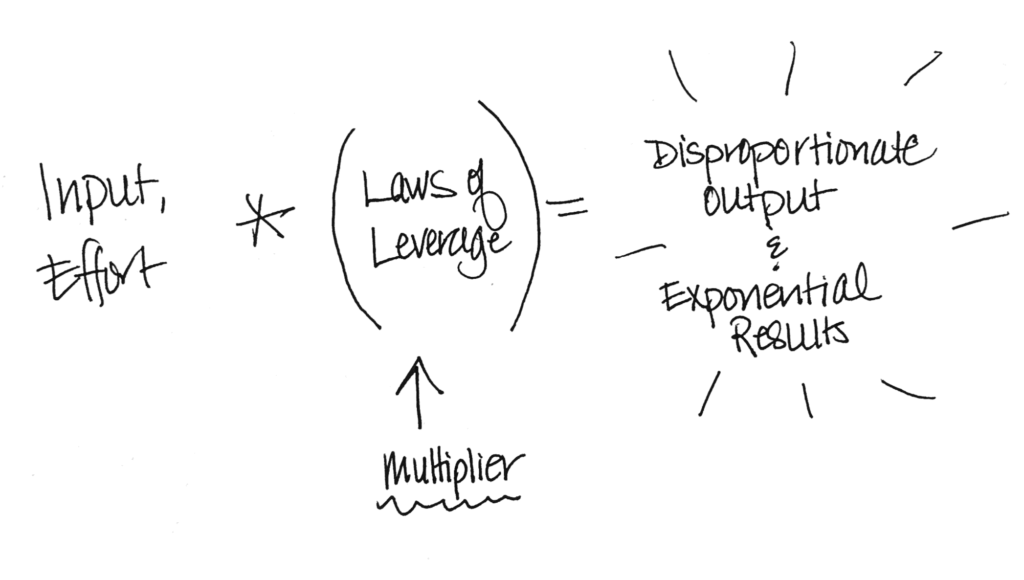
Citation: Hambrick, N. (2025). The 18 Laws of Leverage:The Ultimate Blueprint for Exponential Wealth. Independently published.
Why Read This Book?
Regardless of your industry, The 18 Laws of Leverage offers a refreshing alternative to the constant pressure to do more with less. Rather than simply working harder within constrained resources, this book reveals how to identify powerful leverage points that multiply your impact with less effort. You’ll discover practical strategies to eliminate energy-draining activities that don’t meaningfully contribute to your mission, and learn to focus on the vital 20% of work that produces 80% of your results. I found that seeing these principles organized with compelling examples helped me think differently—revealing opportunities for strategic impact that were hiding in plain sight. The book challenges you to define what “wealth” truly means in your context, whether that’s greater impact, more time, or increased agency in your professional or personal life. And then it gives you 18 wealth productivity hacks.
“If you want an extraordinary life, you must implement extraordinary strategies”
– Nate Hambrick
Key Concept: Leverage
Leverage is anything that acts as a multiplier between the input and effort you give and the output and result you get. When used correctly, leverage offers disproportionate advantages and produces exponential results.
A Snapshot of Three Laws: A Powerful Trio
While all 18 laws offer valuable insights, three laws form a particularly powerful trio for professionals in any line of work. Together, they address the most common challenges:
- the tendency to overwork rather than strategize,
- the attempt to excel in too many areas instead of focusing on strengths, and
- resistance to change rather than embracing adaptability.
Ultimately, these challenges come down to time management and managing our thoughts.

Law 8: Think More Than You Work
Core Principle: Strategy and thinking yield better results than relentless hard work.
Application: Thinking is the work. Step back, notice friction, develop and implement a plan over a specific period of time, reflect on it. Finally, fix the bottlenecks in your strategy.
Quote: “In my mind, the only reason to work in an outdated industry is to innovate and create something new out of the ashes.”
Why It Matters: We often fall into the trap of overwork rather than strategic thinking. With increasing budget constraints, staffing challenges, and mounting expectations, the ability to step back and rethink approaches is essential for success and sustainability. Strategic thinking helps identify leverage points where minimal resources can create maximum impact. And, you can’t think strategically when you’re burned out.

Law 9: Master Your Strengths, Ignore the Rest
Core Principle: Focus on developing your natural talents rather than fixing weaknesses.
Application: Celebrate your genius! Do what only you can do best, then choose the right help from the right people. If you’re a manager, surround yourself by people who have complementary strengths.
Quote: “There’s no sixteen-step formula for becoming Beyoncé.” —Gary Vaynerchuk
Why It Matters: Mission-driven organizations often try to be everything to everyone, diluting their impact. For departments, programs, and organizations facing limited resources, leaning into distinctive strengths creates more meaningful outcomes than attempting to cover all bases adequately. In an increasingly competitive landscape for students, funding, and attention, having a clear strength-based identity makes institutions and organizations more memorable and effective than trying to compete across all domains.

Law 11: Swim With The Tide
Core Principle: Align with consumer trends rather than fighting against them.
Application: Recognize when an industry has fundamentally shifted and have the courage to pivot toward the future.
Quote: “It’s often not the strongest or smartest people who succeed the most when change occurs, but those who are most adaptable to it.”
Why It Matters: Organizations (and the people in them) are naturally resistant to change, often clinging to traditional approaches even as the world transforms around them. With demographic shifts, technological disruption, changing expectations, and evolving social needs, adaptability is a survival skill, not just a nice-to-have quality. The pace of change has accelerated dramatically post-pandemic.
What’s one task, tool, or routine you do every day that might be ready for a rethink—your opportunity to ride the wave of change instead of resisting it?
Conclusion
We all aspire to live well, yet many of us fall into ruts in our thinking and careers that limit what we believe is possible. This narrow perspective affects our work, relationships, and sense of potential. When we view the glass as half-empty, we miss the bigger picture of what’s truly achievable. By expanding our mindset beyond these self-imposed limitations, we can approach our work with more ease and possibility. As we align our actions with this more expansive worldview, new opportunities for joy and fulfillment naturally emerge.
The three laws I’ve highlighted form a powerful framework for transformation:
- Think More Than You Work: Create space for strategy rather than glorifying exhaustion
- Master Your Strengths, Ignore the Rest: Focus on your distinctive excellence rather than trying to be everything to everyone
- Swim With The Tide: Embrace change and adaptation rather than clinging to tradition for tradition’s sake
If wealth is having the time, resources, and agency to design a life on your terms, Hambrick’s book offers us 18 pathways to create greater wealth in our lives. These principles can help us maximize our impact, generate greater wealth (as we define it), and create more fulfilling lives and careers. I highly recommend this book.
Rating (out of 4): 🌟 🌟 🌟 🌟

